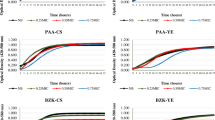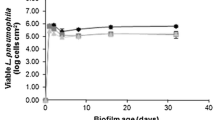Abstract
The ability of heterotrophic plate count bacterial strains isolated from chlorinated drinking water on low-nutrient media to inhibit the growth ofLegionella species was examined. Between 16% and 32% of these strains were able to inhibit the growth ofLegionella species when tested on buffered charcoal yeast extract agar. The exact proportion of inhibiting strains varied with the individualLegionella species. Two strains that inhibited the growth of severalLegionella species could also stimulate the growth of the same species when both the test strain and theLegionella species were grown on buffered charcoal yeast extract agar that lacked the essential amino acidl-cysteine.
Similar content being viewed by others
Literature Cited
Bartlett CLR, Kurtz JB, Hutchison JGP, Turner GC, Wright AE (1983)Legionella in hospital and hotel water supplies. Lancet II:1315
Bohach GA, Snyder IS (1983) Cyanobacterial stimulation of growth and oxygen uptake byLegionella pneumophila. Appl Environ Microbiol 46:528–531
Bohach GA, Snyder IS (1983) Characterisation of surfaces involved in adherence ofLegionella pneumophila toFischerella species. Infect Immun 42:318–325
Carrington GO (1979) Legionnaires' disease bacillus: inhibition by normal flora: Clin Microbiol Newslett: 1:7–8
Chandler FW (1981) In vivo inhibition ofLegionella pneumophila byAspergillus. Lancet I:994
Emmerling P, Sticht-Groh V (1983) In vitro growth inhibition ofLegionella pneumophila by different grampositive and gramnegative organisms. Abstracts of the 39th meeting of the Section Medical Microbiology and Immunology, Deutsche Gesellschaft für Hygiene und Mikrobiologie 1983. Zbl. Bakt. Hyg. A. 256:413
Feeley JC, Gibson RJ, Gorman GW, Langford NC, Rasheed JK, Mackel DC, Baine WB (1979) Charcoal-yeast extract agar: primary isolation medium forLegionella pneumophila. J Clin Microbiol 10:437–441
George JR, Pine L, Reeves MW, Harrell WK (1980) Amino acid requirements ofLegionella pneumophila. J Clin Microbiol 11:286–291
Maki JS, LaCroix SJ, Hopkins BS, Staley JT (1986) Recovery of heterotrophic bacteria from chlorinated drinking water. Appl Environ Microbiol 51:1047–1055
Makin T (1986) Inhibition ofLegionella by other organisms. Med Lab Sci 43:854
Paik G (1980) Reagents, stains and miscellaneous test procedures. In: Lenette EH, Balows A, Hauslew WJ, Truant JB (eds) Manual of clinical microbiology, 3rd edn. Washington: American Society for Microbiology, pp 1000–1024
Pope DH, Soracco RJ, Gill HK, Fliermans CB (1982) Growth ofLegionella pneumophila in two-membered cultures with green algae and cyanobacteria. Curr Microbiol 7:319–322
Reasoner DJ, Geldreich EE (1985) A new medium for the enumeration and subculture of bacteria from potable water. Appl Environ Microbiol 49:1–7
Rowbotham TJ (1980) Preliminary report on the pathogenicity ofLegionella pneumophila for freshwater and soil amoebae. J Clin Pathol 33:1179–1183
Staley JT (1985) Enumeration and identification of heterotrophic bacteria from drinking water. Project summary. United States Environmental Protection Agency Report EPA/600/S2-85/061
Stout JE, Yu VL, Best MG (1985) Ecology ofLegionella pneumophila within water distribution systems. Appl Environ Microbiol 49:221–228
Stout JE, Best MG, Yu VL, Rihs JD (1986) A note on the symbiosis ofLegionella pneumophila andTatlockia micdadei with human respiratory flora. J Appl Bacteriol 60:297–299
Tison DL, Pope DH, Cherry WB, Fliermans CB (1980) Growth ofLegionella pneumophila in association with bluegreen algae (cyanobacteria). Appl Environ Microbiol 39:456–459
Tyndall RL, Domingue EL (1982) Cocultivation ofLegionella pneumophia and free-living amoebae. Appl Environ Microbiol 44:954–959
Wadowsky RM, Yee RB (1983) Satellite growth ofLegionella pneumophila with an environmental isolate ofFlavobacterium breve. Appl Environ Microbiol 46:1447–1449
Wadowsky RM, Yee RB (1985) Effect of non-Legionella bacteria on the multiplication ofLegionella pneumophila in potable water. Appl Environ Microbiol 49:1206–1210
Wadowsky RM, Butler LJ, Cook MK, Verma SM, Paul MA, Fields BS, Keletii G, Sykora JL, Yee RB (1988) Growth-supporting activity forLegionella pneumophila in tap water cultures and implication of Hartmannellid amoebae as growth factors. Appl Environ Microbiol 54:2677–2682
Ward NR, Wolfe RL, Justice CA, Olson BH (1986) The identification of gram negative nonfermentative bacteria from water: problems and alternative approaches to identification. Adv Appl Microbiol 31:293–365
Author information
Authors and Affiliations
Rights and permissions
About this article
Cite this article
Toze, S., Sly, L.I., MacRae, I.C. et al. Inhibition of growth ofLegionella species by heterotrophic plate count bacteria isolated from chlorinated drinking water. Current Microbiology 21, 139–143 (1990). https://doi.org/10.1007/BF02091832
Issue Date:
DOI: https://doi.org/10.1007/BF02091832




